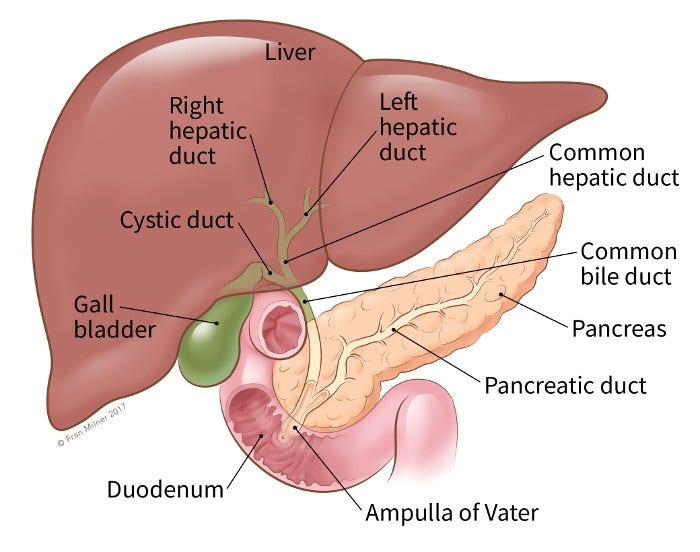Your gift is 100% tax deductible
What Is Gallbladder Cancer?
Gallbladder cancer starts in the gallbladder. To understand this cancer, it helps to know where the gallbladder is and what it does.
About the gallbladder
The gallbladder is a small, pear-shaped organ under the liver. Both the liver and the gallbladder are behind the right lower ribs. In adults, the gallbladder is usually about 3 to 4 inches long and normally no wider than an inch. The liver makes bile and it is either sent into ducts that carry it to the small intestine or stored in the gallbladder and concentrated and released later. Bile helps digest the fats in foods as they pass through the small intestine.

The gallbladder’s wall is made up of 3 main layers of tissue:
- Mucosa (the epithelium and the lamina propria): The innermost layer of tissue that covers the wall of the gallbladder.
- Muscularis: The middle layer of smooth muscle.
- Serosa: The outer layer of tissue.
Primary gallbladder cancer begins in the inner layer and spreads into the outer layers as it grows.
The gallbladder helps digest food, but you don't need it to live. Many people have their gallbladders removed and go on with their everyday lives.
Types of gallbladder cancer
Gallbladder cancers are rare, and nearly all of them are adenocarcinomas. An adenocarcinoma is a cancer that starts in gland-like cells that line many surfaces of the body, including the inside of the gallbladder.
Papillary adenocarcinoma of the gallbladder is a rare type of gallbladder cancer that deserves special mention. The cells in this gallbladder cancer are arranged in finger-like projections. Papillary adenocarcinomas are less likely to spread into the liver or nearby lymph nodes. They tend to have a better prognosis (outlook) than most other kinds of gallbladder cancers.
Other types of cancer that can start in the gallbladder include:
- Adenosquamous carcinomas
- Squamous cell carcinomas
- Small cell neuroendocrine tumors
- Sarcoma
- Lymphoma (these are very rare)
- Written by
- References

Developed by the American Cancer Society medical and editorial content team with medical review and contribution by the American Society of Clinical Oncology (ASCO).
Abou-Alfa GK, Jarnagin W, Lowery M, et al. Liver and bile duct cancer. In: Neiderhuber JE, Armitage JO, Doroshow JH, Kastan MB, Tepper JE, eds. Abeloff’s Clinical Oncology. 5th ed. Philadelphia, PA. Elsevier; 2014:1373-1395.
Patel T, Borad MJ. Carcinoma of the biliary tree. In: DeVita VT, Lawrence TS, Rosenberg SA, eds. DeVita, Hellman, and Rosenberg’s Cancer: Principles and Practice of Oncology. 10th ed. Philadelphia, PA. Lippincott Williams & Wilkins; 2015:715-735.
Last Revised: May 16, 2025
American Cancer Society medical information is copyrighted material. For reprint requests, please see our Content Usage Policy.
American Cancer Society Emails
Sign up to stay up-to-date with news, valuable information, and ways to get involved with the American Cancer Society.



